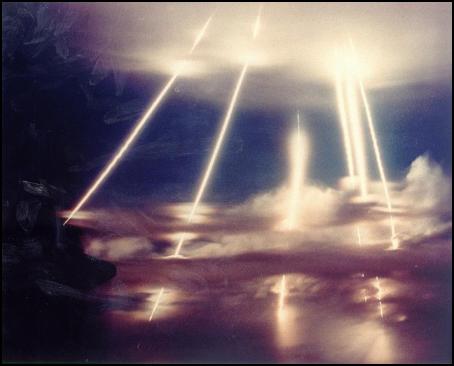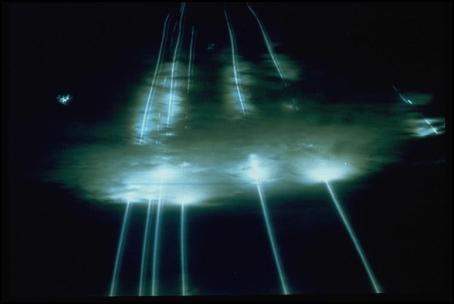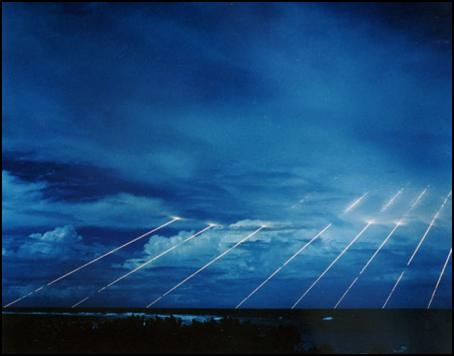Possible Use Of ICBMs Against Iraq – 8 Reasons Why
Possible Use Of ICBMs Against Iraq
Eight
Reasons This Could Be The Pentagon's Secret Plan
By Peter Wills

The attack on Iraq
may begin with the firing of 5-10 conventionally-armed
Intercontinental Ballistic Missiles from the US mainland on
Saddam Hussein "strongholds" in and around Baghdad and
perhaps Tikrit.
Reasons:
1) Public Relations. There is nothing more spectacular than the firey vapour trails from multiple reentry vehicles shooting through the sky at kilometres per second. [See attached pictures.]. The fireworks would be unprecedented, making the beginning of the attack on Iraq as extraordinary as the attack on the World Trade Center. Television cameras could be put in place after the arrival of the first warheads in Baghdad to capture pictures of an even greater shower a couple of minutes later, relayed to American screens in real-time.
2) Complete Surprise. There is no indication that such an attack is coming and there has been complete silence about the possibility. The only warning would be reports from the US that rockets had been launched from silos. The warheads would arrive in Iraq in about 30 minutes, before news reached the outside world. Such an attack would be consistent with Bush's declaration of a 48 hour window for Saddam to leave Iraq with an attack "at time of our choosing".
3) Specific and Personal. The attack would be an expression of American determination to fight Saddam Hussein specifically and remove him by the most direct and powerful military means possible. Having been given 48 hours to leave the country or be attacked, the US has made it clear that the first aim is to strike preemptively against Saddam himself.
4) Putative Accuracy. ICBM strike would be the clearest way to conduct a so-called " surprise surgical strike" against Saddam himself and all his doubles in numerous suspected hideouts nearly simultaneously. Each warhead could contain enough conventional explosive to destroy a significant building. Iraqi intelligence can probably give enough warning of impending cruise missile attack for Saddam to move into the open away from potential target locations.

5) Precedent
Setting. The putative justification for a preemptive
attack on Iraq has no precedent in United Nations history,
leaving it to the US to build a case in terms of its own
determination and the intensity of its own actions. After
using unprecedented military means it is easier to argue
that the situation required their application. By setting
a new precedent the US will have an easier time threatening
the use of even greater force in the future.
6) Perception. The use of ICBMs against an individual/regime makes the missiles look less like weapons of mass destruction (in American hands as opposed to Iraqi hands). The threshold between nuclear weapons (traditionally delivered by ICBMs) and conventional weapons is further blurred, serving US policy interests.
7) Testing. There has never been an opportunity to test ICBMs under "battle" conditions. Of greatest interest will be whether multiple firings have an influence on one another, especially at targets in close proximity. It will be possible to verify strike accuracy afterwards very easily. It is probable that special telemetry aircraft (rather like AWACS) will be safely deployed to gather signals from the incoming warheads.
8) Economics. The time has come to build more ICBMs to keep the arms economy going. Until their real usefulness is demonstrated and the old ones are used up, no new construction is likely to get the go ahead.
Evidence (references below):
1) The Russians believe it is likely and are unhappy about it.
2) The Americans have told the French they can do it
3) The US has developed such a capability
4) $50M was invested as early as 1997 on the development
5) Idea was taken seriously in 1993

References:
1) U.S. TO REDUCE ICBM INVENTORY BY FIRING THEM AT IRAQ?
http://listserv.cddc.vt.edu/pipermail/lnc/2002-August/000326.html
Russia's on-line magazine Gazeta.ru speculates the US will use intercontinental ballistic missiles armed with conventional warheads to attack Iraq. Gazeta.ru referred to July 18 statements by Stephen Younger, head of the Pentagon's Threat Reduction Agency, "to the effect that his unit is working on the issue of using ICBMs with non-nuclear warheads, in a possible armed conflict." Younger apparently did not mention Iraq, but Gazeta.ru wrote: "The Pentagon has declassified yet another detail of the military operation that is being prepared against Iraq. If the United States is unable to reach agreement with [Saddam] Hussein's neighbors on the use of their territory for advance deployment of its troops, the main strike against Iraq will be delivered by ICBMs."
The use of ICBMs would make it possible to destroy even hardened Iraqi military targets--and would be a cheap and efficient way to slash nuclear weapons delivery systems, as mandated under the Treaty on the Reduction of Strategic Offensive Potentials, signed by Presidents Bush and Putin! Gazeta.ru writes that ""as a result of using strategic weapons, the Pentagon will gain unique experience of the combat use of its own ICBM guidance systems--experience which none of the other members of the nuclear club has."
But the alleged plan carries grave and obvious risks. Gazeta.ru concluded that "the use of ICBMs in the operation could trigger an entirely unpredictable reaction not only from Russia, but also from China. And it is not only the fact that ICBM launches against Iraq might be misinterpreted by the Russian missile-attack early-warning system." (Gazeta.ru, July 25)
2) WHAT THE PENTAGON TOLD AGENCE FRANCE PRESSE
http://www.afpc.org/mdbr/mdbr63.htm
Stephen Younger, head of the Defense Threat Reduction Agency, has told the Agence France Presse on July 17th that the idea of using conventional ICBMs for interception or preemption purposes against ballistic missiles and missile launch sites is being seriously explored. According to Younger, the speed of ballistic missiles, as well as their range, make them attractive tools for eliminating missile threats. "[I]f you were to see from a satellite that an adversary was preparing to launch a Scud missile and you had reason to believe there was a biological warhead on it, then you would want to have the ability to destroy that target very quickly before that Scud was launched," he explained. Younger further revealed that "some work" was currently underway at the Pentagon to develop such a capability.
3) DEVELOPMENT OF US CAPABILITY
http://www.wslfweb.org/docs/roadmap/irm/internet/forceapp/init/html/cbmmnn.htm
(U) Conventional Ballistic Missile (CBM) with Maneuverable Non-Nuclear Reentry Vehicle Overview (U):
(U) The Conventional Ballistic Missile (CBM) with Maneuverable Non-Nuclear Reentry Vehicle (MNNRV) supports the Space Force Application mission to conduct global prompt strikes through and from space against terrestrial targets. The MNNRV system would likely be based on the Eastern or Western ranges (ER and WR) to insure treaty compliance with the nuclear ICBMs, and to limit collateral damage from falling boosters. In addition, these systems could be open to inspectors from various countries to provide validity to US claims that they are not nuclear. Additional measures such as introducing an inert material in the propellant which will help distinguish its signature from other missiles could be incorporated. The Maneuverable Non-Nuclear Reentry Vehicle would likely be equipped with either a kinetic energy warhead to penetrate deep and hardened targets or with various submunitions.

4) $50M DEVOTED
TO DEVELOPMENT IN 1997
http://www.cdiss.org/hyper2.htm
Conventional ICBM
Despite the apparent interest in hypersonic cruise missiles, the ballistic missile will still play an important role in U.S. strategy. The strategic arms reduction treaties (START I and II) with Russia are sharply reducing the size and scope of U.S. nuclear forces, including ICBMs and Submarine-Launched Ballistic Missiles (SLBMs). In addition, emphasis on nuclear deterrence has been reduced. As such, interest in conventional military response options is growing and it is in this context that a new conventionally-armed ICBM (CICBM) is being considered. This new missile could offer the U.S. the ability to strike specific target sets, such as hardened or buried targets, without crossing the nuclear threshold. In 1997, the National Security Committee of the U.S. House of Representatives endorsed the CICBM concept and allocated nearly $50 million in funding for a development program.
One recent concept paper written under the auspices of the Air University suggested that a new CICBM could be built at low cost. Spending would also be held down by deploying the missile in a relatively low state of readiness until needed. In another sign of "back to the future" thinking, the new CICBM might employ liquid fuel, in contrast to a more modern but more expensive solid fuel design. The missile's guidance would utilize high-tech GPS technology to ensure the high accuracy needed for a conventional payload. The concept paper's author argues that CICBMs offer U.S. defence planners a flexible response option that would find application in low-intensity conflicts or limited wars and, in such contexts, afford a high probability of target penetration given the lack of anti-ballistic missile defences in the Third World or possessed by rogue adversaries.
However, any move towards deploying new CICBMs would likely raise arms control complications: CICBMs may have to be counted against START warhead ceilings because of the inherent difficulty in distinguishing conventional missile warheads from nuclear warheads in arms control verification regimes. Thus, the U.S. might in effect have to give up some nuclear capability to obtain the advantages of CICBMs. This tradeoff is likely to require further examination by U.S. policymakers and defence planners. Hypersonic missiles are a logical alternative in that they offer similar warfighting capabilities and avoid arms control restrictions.
5) IDEA DEVELOPED IN 1993 AS THE ULTIMATE STANDOFF WEAPON
http://www.airpower.maxwell.af.mil/airchronicles/apj/london.html
Published Airpower Journal - Summer 1993
DISTRIBUTION A:
Approved for public release; distribution is unlimited.
THE ULTIMATE STANDOFF WEAPON
Lt Col John R. London III, USAF
(excerpt)
Another possibility for a long-range strike weapon is the conventionally armed ballistic missile. A large number of Minuteman II intercontinental ballistic missiles (ICBM) are becoming surplus assets as they are taken off strategic alert as a consequence of arms reduction agreements. There is a growing group of potential military and scientific experimenters lining up to use the Minuteman II. Some in the commercial launch community have even discussed using it as a launch vehicle for small payloads. However, the missile would also seem to be an excellent candidate for a carrier vehicle for conventional weapons, at least in the near term. For the long term, however, the unit cost and operating expense of a conventionally armed ICBM needs to approach the cost of a cruise missile if the weapon is to be practical for widespread application. Therefore, the Air Force would ultimately require a completely new ICBM with greatly reduced acquisition and operating costs as compared to ICBMs of the past. This may be possible by eliminating all strategic nuclear vestiges of the ICBM design and emphasizing design and functional simplicity.4


 Binoy Kampmark: Secrecy And Virtue Signalling - Another View Of Signalgate
Binoy Kampmark: Secrecy And Virtue Signalling - Another View Of Signalgate Gordon Campbell: On The Americanising Of NZ’s Public Health System
Gordon Campbell: On The Americanising Of NZ’s Public Health System Ian Powell: Trumpian Health Leadership
Ian Powell: Trumpian Health Leadership Eugene Doyle: Disruption - Historians Challenge Russophobic Propaganda
Eugene Doyle: Disruption - Historians Challenge Russophobic Propaganda Ramzy Baroud: War, Doublethink, And The Struggle For Survival - Geopolitics Of The Gaza Genocide
Ramzy Baroud: War, Doublethink, And The Struggle For Survival - Geopolitics Of The Gaza Genocide Binoy Kampmark: Authoritarian Politics - Netanyahu’s War On Israeli Institutions
Binoy Kampmark: Authoritarian Politics - Netanyahu’s War On Israeli Institutions